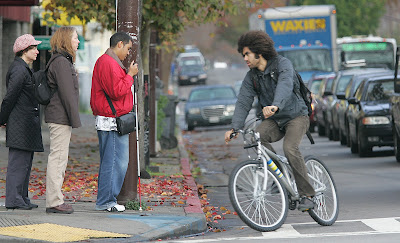By Doug Oakley
Staff Writer
Bay Area News Group East Bay
doakley@bayareanewsgroup.com
Berkeley is the most dangerous city of its size in California for bicyclists and pedestrians, according to the city's police and health departments which received about $400,000 this fall to make the roads safer.
The grants, $200,000 for the police department and $234,000 for the health department, came from the state Office of Traffic Safety.
The office ranks Berkeley No. 1 out of 55 similar-sized cities for bicyclists and pedestrians injured and killed, according to the Berkeley health department.
Police and health officials point out that although Berkeley bikers and walkers are getting injured and killed at a higher rate than other like-sized cities, they also believe there also are more bicyclists and pedestrians in town than in other cities, so the comparison may not be fair.
This year, two pedestrians were killed by cars in Berkeley, according to the police department. One pedestrian died in a hit-and-run accident at San Pablo Avenue and Gilman Street and one died at the hands of a person driving under the influence at Adeline Street and Harmon Street.
In 2009, three pedestrians were killed by cars in Berkeley and 90 were injured. And cars injured 192 bicyclists in 2009.
In 2008, 91 pedestrians in Berkeley were injured by cars and 180 bicyclists were hit by cars, according to the Office of Traffic Safety.
The Berkeley police department will use its grant money for speed detection equipment, a third mobile digital sign, printing for educational fliers and officer overtime during targeted enforcement operations.
"This is a sizable grant for us," said police department spokeswoman Sgt. Mary Kusmiss.
"We'll be handing out educational materials at high-collision intersections, writing citations and educating people about how to walk, ride and drive more safely."
The speed detection equipment will help in writing more speeding tickets for cars and the mobile digital sign can tell drivers how fast they are going and display messages about driving safe, Kusmiss said.
Kusmiss said some of the most dangerous intersections for all kinds of accidents -- car versus bike, car versus pedestrian and car versus car -- are Shattuck and University avenues, San Pablo and Ashby avenues, University Avenue and Sixth Street, Ashby and Shattuck avenues, Ashby and Telegraph avenues, Ashby Avenue and Seventh Street and Ashby Avenue and Martin Luther King Jr. Way.
At the health department, the $234,000 grant will pay for education on bike safety in five elementary schools and the city's two middle schools, a bicycle rodeo in May and the giveaway of 800 free helmets to residents, said Marcia Brown-Machen, who is working on the grant at the health department.
"One of the collaborations we have with the police department is to encourage helmet safety," Brown-Machen said.
"We hope the five target schools adopt a policy requiring kids wear helmets when they ride to school. We'll also have parent monitors at school provide free helmets to those who don't have them."
Brown-Machen said the health department has increased helmet use among Berkeley school students by 56 percent from 2007 to 2009. The department posted parent volunteers at schools to encourage kids to wear helmets, she said. But she added about 36 percent of kids riding bikes to school still don't wear helmets.
According to the police department, drivers who make unsafe turns into bicyclists are responsible for 58 percent of the car versus bike accidents. Drivers who fail to yield to pedestrians in crosswalks are responsible for 56 percent of the car versus pedestrian accidents in Berkeley.
"Often times drivers will not notice when bikes are next to them and they make a turn," Kusmiss said. "Or they park their car and open the door and a bike hits them."
The drivers who hit pedestrians in crosswalks are either inattentive, Kusmiss said, under the influence of alcohol or drugs "or are going too fast to stop in time," or all of the above.
"We always suggest pedestrians be very attentive when they cross the street, make eye contact with the driver or make sure the driver somehow sees you," she said.



No comments:
Post a Comment